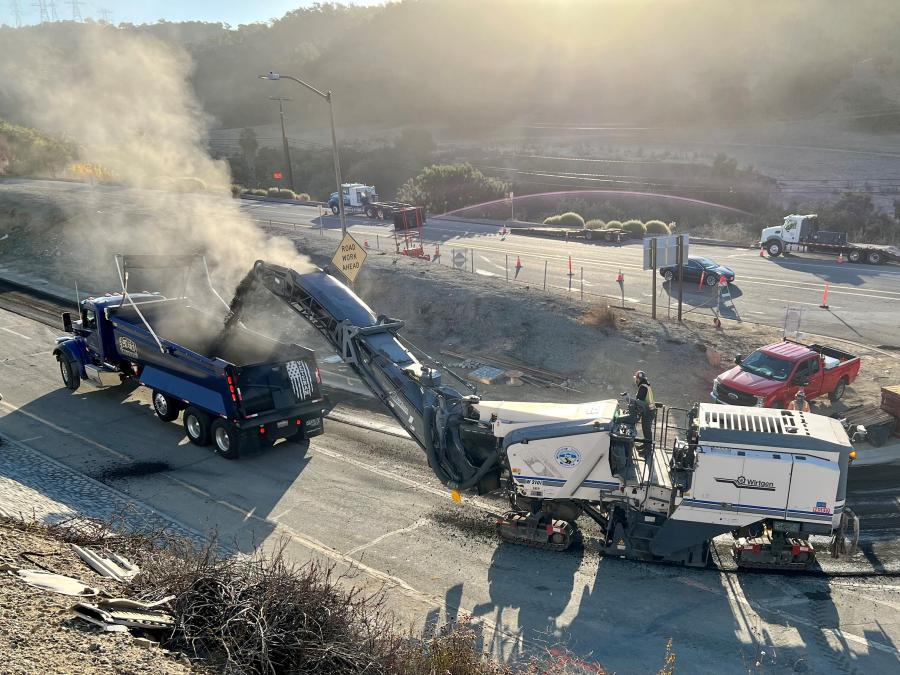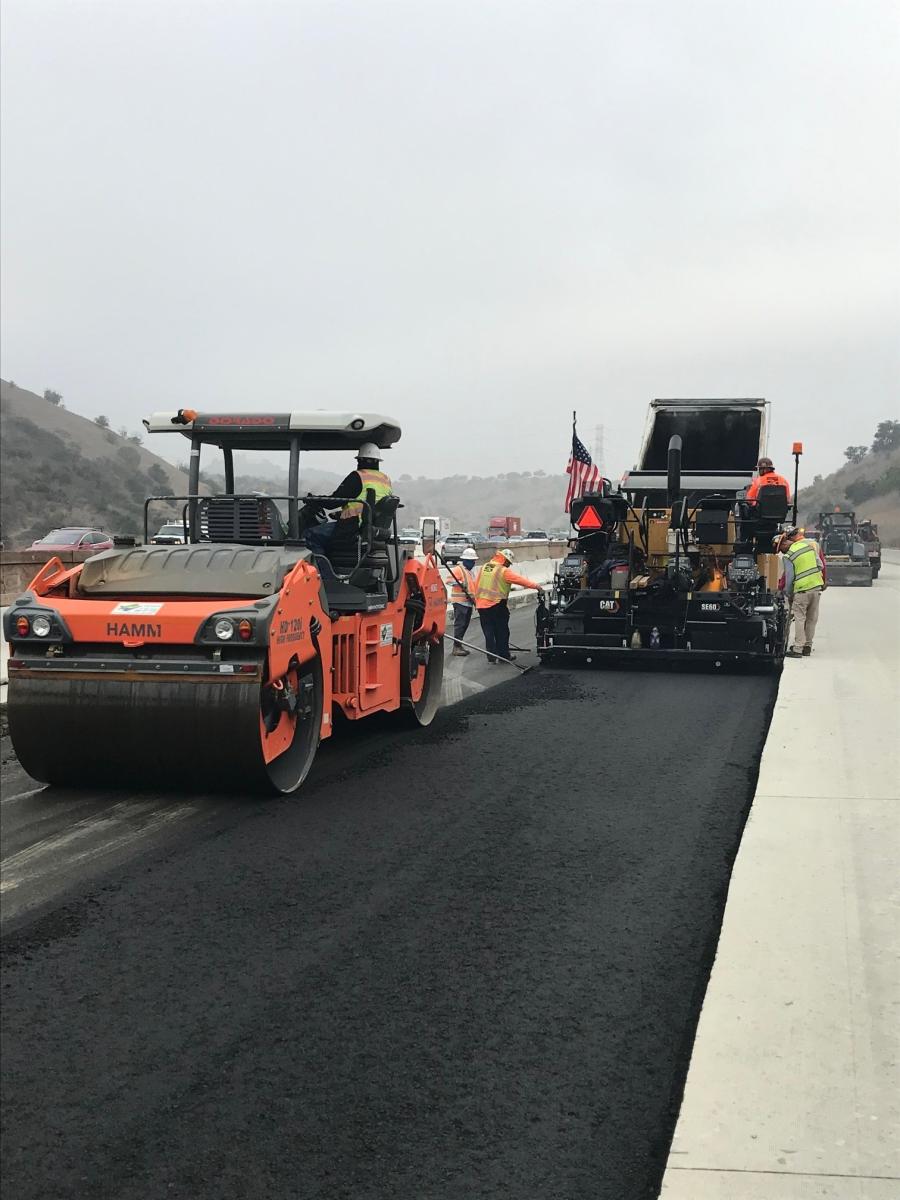The joint venture of Griffith Company and Vanguard Construction is tasked with completing the SR-57 Pavement Replacement Project – a job that is replacing 4.4 mi. of pavement on Los Angeles County highway.(Caltrans photo)
The California Department of Transportation's (Caltrans) $103.98 million SR 57 Pavement Replacement Project that is replacing 4.4 mi. of pavement in Los Angeles County began in August 2020 and is expected to be delivered in 2024.
The 4.4-mi. work zone, where crews from the Griffith Company and Vanguard Construction joint venture (GVJV) are engaged, extends from 57/60 Separation.
The project is restoring and replacing damaged concrete slabs on all lanes and ramps within the project limit; upgrading the concrete median barrier; replacing metal beam guardrails (MBGRs), sign structures and panels; upgrading AC dikes and Americans with Disabilities Act (ADA) curb ramps; replacing traffic loop detectors; and installing 14 permanent treatment best management practice (BMP) devices.
Construction Progress
The Griffith Company-Vanguard joint venture has completed the following: the placement of more than 30,000 cu. yds. of continuously reinforced concrete pavement, more than 4,000 tons of rubberized HMA, 19,000 tons of HMA and other key elements. The remaining work consists mainly of Type 60 median barrier installation.
"Supply chain disruptions caused material lead times to exceed well beyond historical averages," said Dan Leeper, Griffith's senior project manager. "This challenged GVJV to improve in our planning/ coordinating efforts to minimize any delays or impacts to the project. The rainstorms we experienced this past winter created some down time industry wide, however we have been able to pick back up and maintain an on-time construction schedule. We are completing the median replacement [Stage 5] and expect to finish Q1 2024.
"The crews have worked diligently to work safely around all known utilities," he added. "There have been minimal issues with soil, water and utilities. This is a heavily traveled area. Stage 0 required the installation of 25 new shoulder drainage systems with some work zones as narrow as 12-feet wide. This created challenging access constraints to achieve the work in a cost effective and timely manner."
Relations with Caltrans are very good.
"Griffith Company is a major proponent of project partnering," said Leeper. "Partnering is a formal conflict resolution process tool to ensure projects are constructed with lessened conflict and minimal claims. At the beginning of the project a partnering workshop is held with the owner's and the contractor's project teams as well as third party stakeholders. At this meeting, with the help of a professional facilitator, project goals are discussed, identified and written out as a project charter.
"Although each project is unique, goals are set for safety, project growth, profitability, schedule, quality, impact to the community and zero claims," he added. "In addition, a formal dispute resolution ladder is created to ensure disputes are elevated to the appropriate level for quick resolution. On a monthly basis during the project, surveys from each team member are submitted to rate the success of partnering and the project goals. Much of the survey revolves around how well the team is communicating and getting along, as this is an indicator of the health of the team."
The work to restore and replace damaged concrete slabs for the lanes and ramps proceeded well.
"Mainline CRCP was installed behind K-rail," said Leeper. "After removals and grading, crews worked during the day installing rebar while crews worked at night installing concrete. Mainline JPCP [RS] was installed over the course of eight EA extended weekend closures. Griffith Company proposed value engineering to Caltrans to reduce project costs and schedule by modifying the pavement section to include a geogrid. This Value Engineering Change Proposal (VECP) reduces the amount of soil and bulk material export and import to the project. Not only did this decrease project costs but it also improved traffic congestion and had environmental benefits."
CRCP was installed two lanes at a time, while the JPCP (RS) was installed both two lanes and one lane at a time.
"For concrete installation, working at night is preferred because traffic is light which allows for the most efficient delivery of material," said Leeper. "Additionally, in summer months, night work is necessary to install concrete because of high daytime temperatures."
For this element, crews used a GOMACO 2400 slipform paver, a GOMACO RTP 500 rubber track paver and a GOMACO texture/cure machine.
After installation of median drainage systems, the median barrier will be installed via slip form and fixed form methods. This work will be performed behind K-rail.
"The first barrier pour was at the end of June," said Leeper. "The work is expected to be complete in early 2024. Rebar and forms will be installed during the day. Concrete installation will take place at night. For concrete installation, working at night is preferred."
A GOMACO Commander III paver is essential for this work.
Existing underground utilities are the leading concern when installing metal beam guardrail.
"Coordination and planning must be completed internally with the project team and externally with third party utility owners to ensure the work is completed without incident," Leeper explained. "In regards to overhead sign structures, existing underground utilities are also a leading concern when installing overhead sign foundations, however another challenge is the layout and grade. The foundation and sign structure must be installed to allow proper clearance for vehicles, and primarily trucks, to pass under.
"The layout of loops is critical," he added. "Before loops can be installed the final striping alignment must be in place. If the loop is installed offset from the centerline of the lane, the system will fail to detect vehicles."
"Loops will be the last order of business for this project," said Leeper. "This is tentatively scheduled for April 2024.
For the guardrail installation, a skid steer with an auger attachment was employed; a Bay Shore system lodril crane is helping with the installation of the overhead signs.
Griffith Company's management team consists of Nathan Lopez, project manager; Kyle Hunter, area superintendent; Brian Watson, project superintendent; Joe Roa, project foreman; Richard Oliva, project foreman; and Project Engineers Awad Issa and Stephen Baca. Vanguard's management team consists of Project Manager Jackson Lacombe and Project Engineer Nikhil Lakkamraju.
"The team dynamic was positive," said Leeper. "The crews and field supervision did a great job. In particular, a project like this requires extraordinary communication as crews are working day and night."
Peak days have had 50 Griffith Company, Vanguard and subcontractor employees on-site. The subcontractors include Ace Fence for fencing and guardrail; APCO for AC dike; CGO Construction for clearing and grubbing; Concrete Coring Company for sawcutting; Coral Construction for overhead signs; Statewide Traffic Safety & Signs for signage; Maneri Traffic Control for traffic control; VT Electric for electrical; G3 Quality for quality and material testing; and Mahaffey Drilling for CIDH foundations.
Excavation and demolition generated 162,000 tons of concrete rubble and debris, and 36,000 tons of earth and rock.
"All concrete rubble was recycled and crushed for re-use as road base," said Leeper.
New materials will include 30,000 cu. yds. of concrete, and 25,000 tons of asphalt.
Other equipment on-site includes an Erie Strayer MG 12-CP batch plant, mobile track crusher, a KPI FT4250CC and FT2650, a John Deere 210 skip loader and a JCB 6K forklift,
"This corridor is in a densely populated metropolitan area, so any normal issues of wear and tear are able to be addressed timely to avoid schedule impact," said Leeper. "Mechanics are dispatched to the project for routine maintenance, fueling and as necessary due to unforeseen events."
Griffith purchases and rents equipment from numerous vendors.
"Developing positive relationships is central to Griffith Company's way of doing business," said Leper. "Maintaining these relationships is important so that we have a partner that wants to help when we need it." CEG
Irwin Rapoport
A journalist who started his career at a weekly community newspaper, Irwin Rapoport has written about construction and architecture for more than 15 years, as well as a variety of other subjects, such as recycling, environmental issues, business supply chains, property development, pulp and paper, agriculture, solar power and energy, and education. Getting the story right and illustrating the hard work and professionalism that goes into completing road, bridge, and building projects is important to him. A key element of his construction articles is to provide readers with an opportunity to see how general contractors and departments of transportation complete their projects and address challenges so that lessons learned can be shared with a wider audience.
Rapoport has a BA in History and a Minor in Political Science from Concordia University. His hobbies include hiking, birding, cycling, reading, going to concerts and plays, hanging out with friends and family, and architecture. He is keen to one day write an MA thesis on military and economic planning by the Great Powers prior to the start of the First World War.
Read more from Irwin Rapoport here.
Today's top stories


















